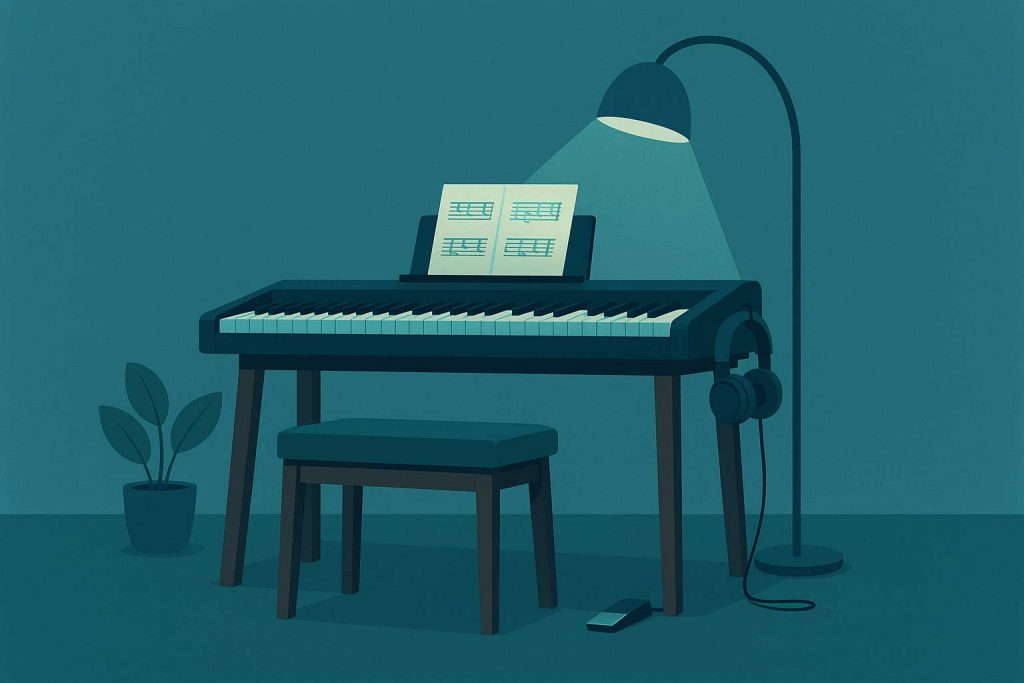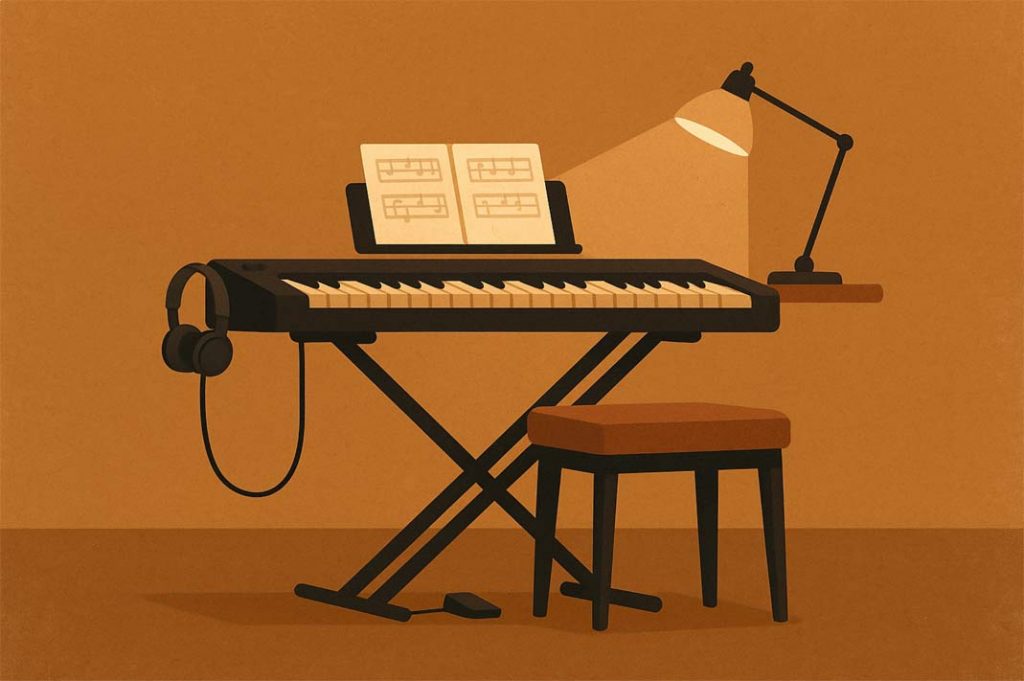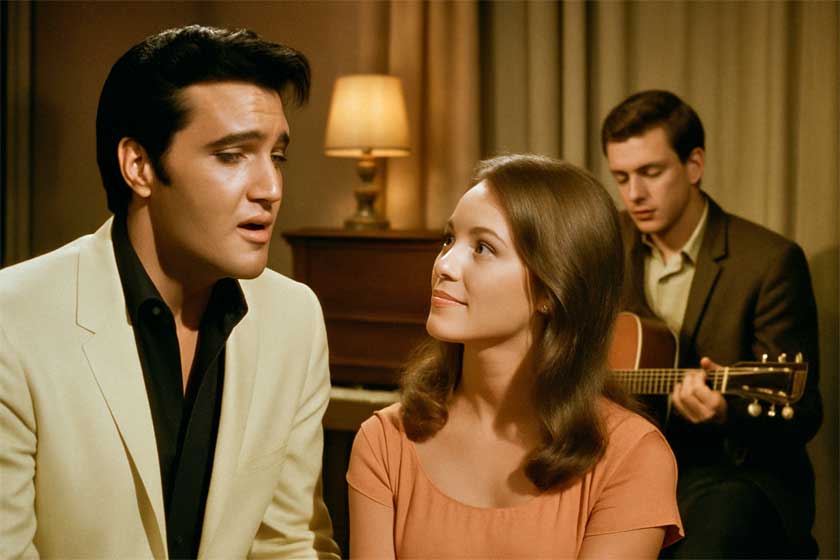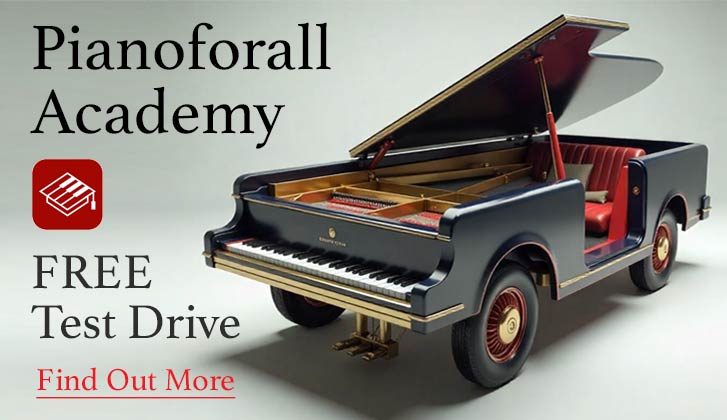Last updated: 17 September 2025 — Prices checked this month. Prices change with sales and bundles; treat these as ballpark. (Notes shown in £ and $.)
Quick picks
- Best first choice: 88-key, fully-weighted digital piano with built-in speakers.
- Budget/space: 61–76 keys, good key feel, headphone jack, sustain pedal input.
Who this is for
Adults buying their first keyboard/digital piano who want the best feel for the money, without being up-sold on features they’ll never use.
Why I used to say “piano only” (and what I say now)
The question I get most from adults is: “What’s the best keyboard to start with?” It depends on budget, space, and what keeps you practising. I used to say “ignore the bells and whistles—just get the best piano feel and sound.” Then I spent time with the backing rhythms on my Roland and noticed something obvious: some beginners practise longer (and keep better time) when there’s a rhythm section behind them. So my view is wider now.
Spending more usually gets you better sound, feel, and speakers—but choosing the right type of instrument matters even more.
Keyboard vs digital piano (what you’re really choosing)
Digital pianos are “piano first”: 88 keys, weighted/hammer action, built-in speakers and a few core sounds. Best for building proper technique.
Portable keyboards/arrangers are “fun first”: usually 61 or 76 lighter keys, hundreds of sounds, and backing rhythms that follow your chords. Great for staying on the beat, improvising, and composing.
Hybrids like Yamaha DGX-670 give you both: weighted keys and styles in one box.
What actually matters (rank these for yourself)
- Key feel. Weighted/hammer actions feel closer to a real piano. Semi-weighted and light “synth” actions are easier to press but don’t build the same finger strength.
- Number of keys. 88 is best for piano. 61 works for arranger fun; 76 is a useful middle ground.
- Touch response (non-negotiable). If pressing harder doesn’t make it louder, don’t buy it.
- Speakers/headphones. Bigger speakers sound fuller; headphones keep neighbours happy.
- Connectivity. USB-MIDI for talking to apps/computers; USB-audio and/or Bluetooth are handy extras.
- Styles/rhythms. If a beat makes you practise longer, prioritise a model with decent accompaniment.
- Footprint & furniture. Portable slab + stand vs a home cabinet with three pedals.
- Budget now vs upgrade later. Cheap but playable is fine; unplayable is not.
Key actions, plain English
Weighted/hammer: closer to acoustic feel; heavier in the bass, lighter up top. Best for technique and dynamics.
Semi-weighted/light: easier to press and quick for synth parts; less “piano-like.”
If you’re serious about piano, start with weighted keys if you can.
Do you want backing rhythms?
If styles help you practise, it’s not “cheating,” it’s smart. For lighter keys and lots of styles, look at Yamaha PSR-E473 (61-key) or EW425 (76-key). If you want rhythms and weighted keys, Yamaha DGX-670 is the obvious pick.
Connectivity without the jargon
USB-MIDI lets you use apps, notation, and DAWs. USB-audio records high-quality sound straight over a cable. Bluetooth (audio and/or MIDI) is handy but not essential. Roland FP-30X and Casio PX-S1100 are easy “plug and play” examples.
Recommended models (with price notes)
Starter digital pianos (weighted 88-key)
- Yamaha P-145: compact, sturdy, gets the fundamentals right
— £339–£439 / $430–$560 - Roland FP-10: firm PHA-4 feel; great value
— £359–£399 / $455–$505
Step-up for feel/features
- Kawai ES120: natural touch and tone
— £519–£529 / $660–$670 - Casio PX-S1100: ultra-slim; easy Bluetooth pairing
— £419–£439 / $530–$560 - Yamaha P-225: more refined engine than P-145
— £439–£499 / $560–$635
More power or “arranger-piano” hybrid
- Roland FP-30X: bigger speakers, 256-polyphony, strong all-rounder
— £549–£575 / $695–$730 - Yamaha DGX-670: weighted keys + full styles: a band in a box with piano feel.
— ~£699 / ~$890 base; £1,019–£1,260 / $1,295–$1,600 with stand/pedal bundles
Arranger fun (lighter keys)
- Yamaha PSR-E473 (61-key): tons of sounds and effects; easy to jam
— £285–£309 / $360–$390 - Yamaha PSR-EW425 (76-key): same engine, more keys
— £409–£419 / $520–$530
“Which Yamaha?” at a glance
- P-125 = Now discontinued but a great choice if you can still find one new or second hand
- P-145: entry portable digital piano with proper weighted feel.
- P-225: step-up engine/refinement; optional L-200 stand.
- DGX-670: weighted 88 with full arranger styles.
- YDP-145: home cabinet version
— £729–£745 / $925–$945
If learning piano is the goal, P-145 / P-225 / FP-10 / FP-30X / ES120 / PX-S1100 all make sense. If styles are the priority, PSR-E473/EW425 or DGX-670.
Looking at Yamaha P-45? Similar-price options
Yamaha P-45 is an 88-key weighted starter that’s simple and reliable. The sound is recognisably Yamaha and the action is perfectly serviceable. It’s basic on speakers and features, but if you find a good deal, it will do the job for learning.
Typical: £269–£359 / $340–$455.
If prices are close, the newer P-145 or Roland FP-10 are usually safer long-term buys.
Other rivals worth a look:
Casio CDP-S110 (£255–£268 / $325–$340),
Korg B2 (£299–£368 / $380–$465),
Alesis Recital Pro (£270–£361 / $345–$460).
Brands, quick character sketch
- Yamaha: bright, clear pianos; reliable actions; big arranger range.
- Casio (Privia): slim, clever, strong value; good actions at the price.
- Roland: punchy sound; firm, precise feel; solid connectivity.
- Kawai: natural piano tone/feel; musician-pleasing even at lower prices.
- Korg: decent budget digitals and stage gear; try the action first.
Unknown brands — should you bother?
They can be fine for a tight budget or a temporary start, but actions, samples and support vary a lot. If you go this route, try it in person, check return policies, and buy from a retailer who’ll look after you.
Stands, seats & pedals (spend a little, thank yourself daily)
Stand: X-stands are cheap but can wobble. A matched wooden stand sets the right height and feels stable.
Seat: height-adjustable bench if you can.
Pedal: get a sturdy, piano-style metal sustain pedal. If your model supports half-damper, buy the maker’s compatible pedal; otherwise a universal (e.g., M-Audio SP-2) is fine.
Start cheap then upgrade later?
Yes—if the cheap keyboard has touch response and doesn’t feel or sound awful. If it does, you’ll practise less and quit sooner. A solid entry digital piano like P-145, FP-10 or ES120 keeps you motivated and resells easily when you’re ready to upgrade.
Try-before-you-buy (showroom game plan)
I know it can feel daunting to walk into a music shop and try keyboards when you can’t really play yet. If you know someone who plays, bring them so you can hear what each keyboard sounds like.
If you can play even a little, take your own headphones, plug in, and try each one just to get the feel of the keys—you learn far more from touching a keyboard than from any YouTube review. Try a few rhythms too: a simple pop ballad, some jazz swing, or a slow blues.
Check the “split” function (bass on the left, piano on the right). On many Rolands the left-hand bass will sustain with the pedal, which sounds great; on many Yamahas the bass doesn’t sustain in split, which I don’t like—see what you prefer.
And if you’re starting from scratch, tell the person in charge of keyboards that you’re a complete beginner choosing your first instrument and ask if they can play a few models so you can hear them. That’s their job, and most are happy to help.
Related guides
Note: Prices and bundles change often by retailer and region. If you see a price out of line, it’s usually a bundle (stand/pedals) or a sale. Always check what’s included.
To sum up
- Prioritise key feel over flashy features.
- 88 weighted if you can; 61–76 with decent action if you can’t.
- Check headphone, sustain pedal, and USB before you buy.
- Set height and seating correctly—your hands will thank you.






